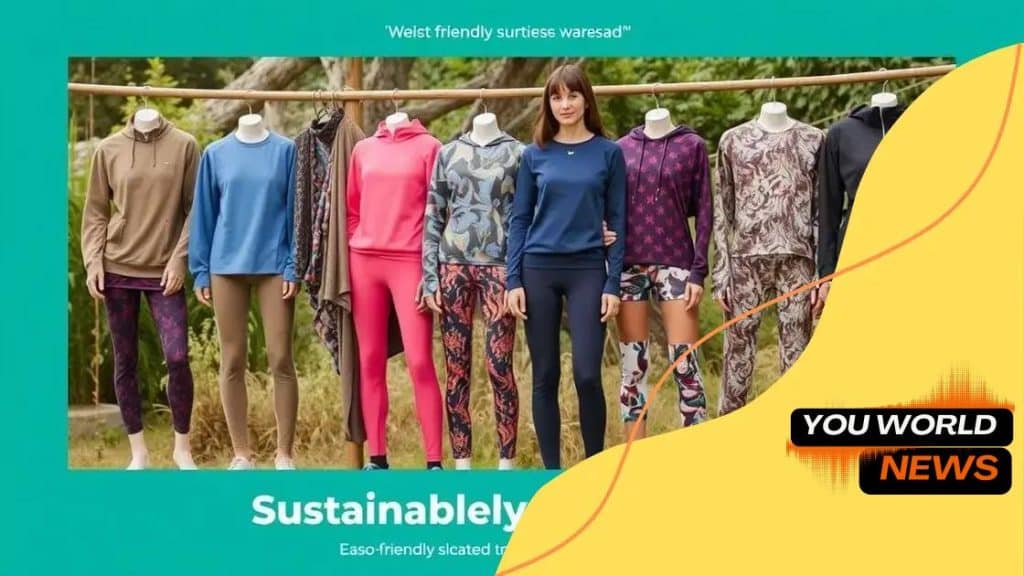The best sustainable activewear brands in 2025

The best sustainable activewear brands in 2025 prioritize eco-friendly materials, ethical production practices, and versatile designs, catering to environmentally conscious consumers who seek both style and sustainability.
The best sustainable activewear brands in 2025 are more than just a trend—they’re a movement. Have you ever wondered how your workout gear impacts the planet? With an increasing focus on eco-conscious choices, these brands are leading the charge.
Top sustainable brands to watch in 2025
As we look toward the future, the top sustainable brands to watch in 2025 are revolutionizing the way we think about fashion, especially activewear. These brands are committed to creating stylish, functional pieces while also prioritizing the planet.
One standout is Patagonia, which has long been a leader in environmental responsibility. Their commitment to using recycled materials and ethical manufacturing processes makes them a favorite among eco-conscious consumers. Nike is also making strides with their Move to Zero campaign, focusing on reducing waste and carbon emissions.
Emerging Brands to Note
Several emerging brands are worth keeping an eye on as they gain traction in the activewear market:
- Girlfriend Collective: Known for their size inclusivity and sustainable fabrics.
- Vuori: Focuses on versatility and comfort with eco-friendly materials.
- Allbirds: Although primarily a shoe company, their move into activewear highlights sustainability.
- Nimble Activewear: Australian brand renowned for its commitment to recyclable materials.
The fashion industry is seeing a shift where consumer choices are driven by sustainability. This growing demand means that established brands are responding by innovating and creating greener products, making it an exciting time for those who value ethical fashion. As we continue to support these initiatives, it’s crucial to understand the impact our choices make on the environment.
By choosing clothing from these sustainable brands, you not only enhance your workout wardrobe but also contribute to a healthier planet. It’s an investment in your health and the future of our environment.
Innovative materials used in activewear
In the world of activewear, choosing the right materials can make a huge difference. Brands are now focusing on innovative materials that not only increase performance but also reduce environmental impact.
Many brands are using recycled polyester, which is made from plastic bottles. This process helps divert waste from landfills and reduces the need for new materials. Another popular choice is organic cotton, grown without harmful pesticides and chemicals. This keeps the environment healthier.
New Technologies in Fabrics
Aside from traditional materials, new technologies are transforming how we think about fabric:
- Bamboo fibers: Naturally moisture-wicking and biodegradable.
- Merino wool: Regulates body temperature and is compostable.
- Graphene: Provides enhanced durability and thermal control.
- Modal: Made from beech tree pulp, it’s soft, breathable, and eco-friendly.
These materials do more than just reduce environmental footprints. They also enhance the user experience, offering comfort and longevity. For example, many activewear brands are now incorporating anti-odor technologies into their fabrics, which help keep workout gear fresh for longer periods.
The shift towards sustainable materials is evident in the activewear industry. Consumers are increasingly wanting to know where their clothes come from. As a result, brands that prioritize innovation and environmental consciousness stand out. By selecting activewear made from these innovative materials, you’re making a statement about your commitment to both fitness and the planet.
How sustainability is changing workout fashion

Today, sustainability is reshaping workout fashion in exciting ways. With more brands committing to eco-friendly practices, consumers can not only look great but also feel good about their choices.
The movement towards sustainable fashion has pushed many companies to rethink their materials and manufacturing processes. For instance, brands are now using organic cotton and recycled fabrics in their products. This shift has resulted in stylish options that don’t sacrifice quality for ethics.
The Rise of Eco-Conscious Brands
As the demand for sustainable clothing grows, many new and established brands are stepping up:
- Outdoor Voices: Known for their vibrant, mood-boosting styles that use recycled materials.
- Alo Yoga: This brand combines luxury and sustainability, using organic and recycled fabrics.
- Pact: Focuses on fair trade and organic materials, championing comfort and style.
- Rhone: Targets men with premium fitness wear made from eco-friendly sources.
These brands are not just about selling clothes; they are creating a movement. Consumer awareness is driving brands to reduce waste and promote ethical production practices. Shoppers are now more informed, actively seeking brands that align with their values.
This change in demand encourages companies to innovate. Styles that were once overlooked in favor of fast fashion are now getting the attention they deserve. Brands are designing collections that blend style with function while remaining environmentally responsible.
The aesthetic of workout clothes is also evolving. Athletes are now looking for versatile pieces that can be worn in multiple settings, from the gym to casual outings. This versatility comes with the understanding that sustainability and style can go together. It shows how fitness fashion is transitioning into everyday life.
Consumer trends in eco-friendly activewear
Consumer trends in eco-friendly activewear reveal a growing preference for sustainable practices. With increasing awareness about climate change and pollution, shoppers are becoming more conscious about the brands they support.
Today’s consumers are seeking activewear that reflects their values. They want clothing made from renewable resources, such as organic cotton and recycled materials. This trend is evident in the rise of brands focusing solely on sustainability.
Key Trends in Eco-Friendly Activewear
Let’s explore some significant consumer trends:
- Transparency: Shoppers demand information about where their clothes come from and how they are made.
- Versatility: Consumers are looking for activewear that can transition from workouts to daily life seamlessly.
- Quality over quantity: There is a shift towards investing in fewer, high-quality pieces instead of fast-fashion items.
- Supporting local brands: More people are choosing to buy from environmentally responsible local companies.
Moreover, social media plays a vital role in these trends. Influencers promote eco-friendly brands, reaching audiences who value sustainability. The connection between lifestyle and environmental consciousness is stronger than ever.
Another interesting trend is the focus on circular fashion. Many consumers appreciate brands that offer take-back programs or recycling options. This approach helps reduce waste and promotes a more sustainable cycle of use.
The preferences of today’s shoppers reflect a transformation in the activewear industry. As consumers continue to prioritize sustainability, brands that adapt to these trends will thrive. By understanding and embracing these shifts, both consumers and brands can contribute to a healthier planet.
Tips for choosing sustainable activewear
Choosing sustainable activewear can feel overwhelming, but it doesn’t have to be. By following some simple tips, you can make informed decisions that benefit both your wardrobe and the planet.
First, look for brands that prioritize eco-friendly materials. Fabrics like organic cotton, recycled polyester, and Tencel are excellent choices. These materials reduce environmental impact and often provide great comfort and durability.
Check for Certifications
Another key factor is to look for certifications. Brands that have third-party certifications, such as Global Organic Textile Standard (GOTS) or OEKO-TEX, indicate a commitment to sustainability. These labels mean that the products meet specific environmental and social criteria.
When shopping, consider the production process of the activewear.
- Fair Trade: Look for brands that support fair trade practices, ensuring workers are paid fairly and work in safe conditions.
- Local Production: Opt for brands that manufacture locally to reduce carbon footprints related to shipping.
- Transparency: Choose brands that are open about their sourcing and production methods.
Another tip is to assess the longevity of the activewear. Items that can withstand multiple washes without losing their shape or color are more sustainable. Additionally, think about versatility. Pieces that can be worn for different activities or occasions extend their life in your wardrobe.
Finally, don’t be afraid to ask questions. Reach out to brands about their sustainability practices. The more informed you are, the better choices you can make. Remember, every purchase is a step towards more conscious consumerism.
FAQ – Sustainable Activewear Questions
What materials should I look for in sustainable activewear?
Look for eco-friendly materials like organic cotton, recycled polyester, and Tencel, which have a lower environmental impact.
How can I verify if a brand is truly sustainable?
Check for certifications like GOTS or OEKO-TEX, which indicate that the brand meets specific environmental and ethical standards.
Why is versatility important when choosing activewear?
Versatile activewear can be worn for various activities, extending its usability and reducing the need to buy more clothing.
How can I support local sustainable brands?
You can support local brands by researching companies in your area that use sustainable practices and prioritizing them in your purchases.





